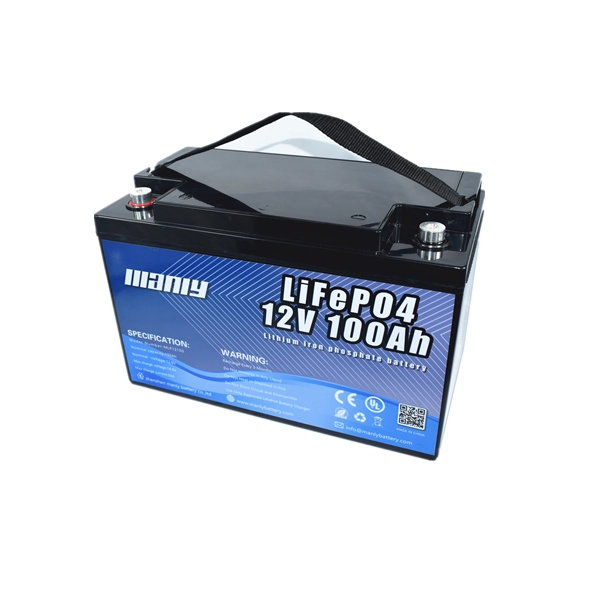1. Definizione di robot agricolo:
Sommario
2.Come vengono utilizzati i robot in agricoltura
Robots are widely used in agriculture to revolutionize farming practices and address the challenges faced by the industry. These robots offer numerous benefits and advancements that enhance farming efficiency and productivity. They are equipped with cutting-edge technologies, including artificial intelligence and machine learning, to perform complex tasks efficiently.Agricultural robots provide real-time data gathering and analysis capabilities through the use of drones, enabling informed decision-making in crucial farming processes such as planting, irrigation, and pest control. This data-driven approach leads to improved crop yields, reduced costs, and optimized resource allocation. These robots also offer enhanced efficiency compared to traditional farming methods, resulting in significant time and cost savings for farmers.The implementation of robots in agriculture faces challenges such as high initial investment costs and the lack of rural infrastructure for large-scale adoption. However, successful deployments have been observed worldwide, with Japan and Europe leading the way in utilizing robots for tasks such as harvesting, soil analysis, weeding, pruning, and planting. These robots have demonstrated increased efficiency and cost reduction in farming operations.The development and integration of artificial intelligence into agriculture have further expanded the capabilities of agricultural robots. AI-driven decision support systems, such as yield prediction systems, enable farmers to make informed choices based on large datasets and sophisticated computer programs. This integration allows for more precise and optimized farming practices, contributing to increased agricultural productivity and sustainability.Responsible innovation and user-centered design are crucial considerations in the development and adoption of autonomous robots in agriculture. As the field of agricultural robotics continues to evolve, ongoing research and inclusive discussions are needed to address ethical, social, and policy issues related to the responsible use of these technologies.In conclusion, robots have transformed agriculture by offering advanced capabilities in data gathering, analysis, and decision-making processes. With their integration of artificial intelligence and machine learning, agricultural robots enable farmers to achieve higher efficiency, productivity, and sustainability in farming practices. The ongoing development and adoption of these technologies contribute to the growth and evolution of the agricultural industry.3. Tipi di robot agricoli:
3.1 Robot di raccolta
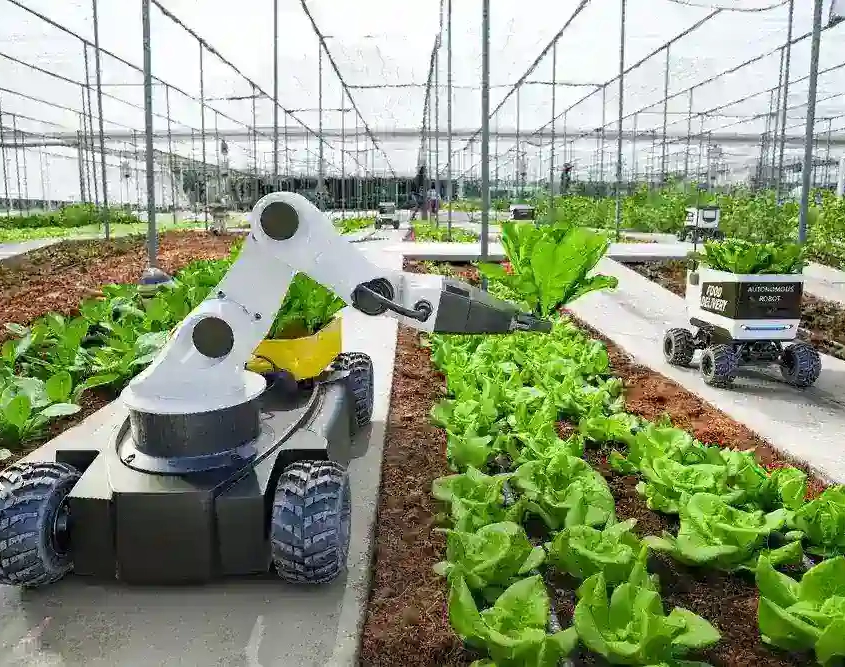 The introduction of picking robots in agricultural has the potential to revolutionize farming practices and address key challenges faced by the industry. As the world's population continues to grow, there is an increasing demand for food production. However, labor shortages and the need for higher productivity and efficiency pose significant obstacles.Agricultural robots, including picking robots, offer promising solutions to these challenges. These robots can automate labor-intensive tasks involved in selective harvesting, such as picking high-value crops like apples, tomatoes, and broccoli. By using sensors, cameras, and robotic arms or grippers, picking robots can detect when crops are ripe and harvest them carefully without causing damage.The adoption of picking robots brings numerous advantages to the agricultural sector. They offer increased efficiency, accuracy, and reduced labor costs. With the ability to work continuously and tirelessly, these robots can enhance productivity and help meet the growing demand for agricultural products. Moreover, picking robots can alleviate the physical strain and repetitive nature of agricultural tasks, improving the overall working conditions for farmers.Research and development in agricultural robotics have made significant progress, with a focus on addressing the limitations of current systems and exploring future possibilities. The use of robots in agriculture has implications beyond environmental and economic aspects, including political, social, cultural, and security considerations. Ethical challenges associated with the widespread use of agricultural robots are being examined, and key policy choices are being highlighted to maximize the benefits of robotics in agriculture.In conclusion, the introduction of picking robots in agricultural robotics presents an exciting opportunity to transform the farming industry. These robots offer innovative solutions to labor shortages, increase productivity, and improve overall efficiency in selective harvesting tasks. As the field of agricultural robotics continues to advance, it is crucial to consider the ethical, policy, and societal implications to ensure the optimal utilization of this technology.
The introduction of picking robots in agricultural has the potential to revolutionize farming practices and address key challenges faced by the industry. As the world's population continues to grow, there is an increasing demand for food production. However, labor shortages and the need for higher productivity and efficiency pose significant obstacles.Agricultural robots, including picking robots, offer promising solutions to these challenges. These robots can automate labor-intensive tasks involved in selective harvesting, such as picking high-value crops like apples, tomatoes, and broccoli. By using sensors, cameras, and robotic arms or grippers, picking robots can detect when crops are ripe and harvest them carefully without causing damage.The adoption of picking robots brings numerous advantages to the agricultural sector. They offer increased efficiency, accuracy, and reduced labor costs. With the ability to work continuously and tirelessly, these robots can enhance productivity and help meet the growing demand for agricultural products. Moreover, picking robots can alleviate the physical strain and repetitive nature of agricultural tasks, improving the overall working conditions for farmers.Research and development in agricultural robotics have made significant progress, with a focus on addressing the limitations of current systems and exploring future possibilities. The use of robots in agriculture has implications beyond environmental and economic aspects, including political, social, cultural, and security considerations. Ethical challenges associated with the widespread use of agricultural robots are being examined, and key policy choices are being highlighted to maximize the benefits of robotics in agriculture.In conclusion, the introduction of picking robots in agricultural robotics presents an exciting opportunity to transform the farming industry. These robots offer innovative solutions to labor shortages, increase productivity, and improve overall efficiency in selective harvesting tasks. As the field of agricultural robotics continues to advance, it is crucial to consider the ethical, policy, and societal implications to ensure the optimal utilization of this technology.3.2 Robot per innesto
Grafting robots are innovative machines that automate the grafting process in agriculture, improving efficiency and enhancing seedling survival rates. These robots have gained attention worldwide, and researchers are exploring key technologies and components involved in vegetable grafting robots. Seedling feeding, clamping, and cutting devices play crucial roles in the design and operation of these robots. Machine vision technology plays a vital role in automating the grafting process, enabling accurate seedling recognition, classification, and detection.The integration of grafting robots in agriculture presents both benefits and challenges. These robots contribute to increased productivity, improved crop quality, and reduced labor requirements . However, challenges include speed limitations, integration with seedling biotechnology, and achieving consistent quality and speed. Ongoing research focuses on enhancing intelligence, machine vision, artificial intelligence (AI), and automation to overcome these challenges and further optimize grafting robots.The use of agricultural robots and drones, including grafting robots, is revolutionizing farming practices. These technologies leverage computational algorithms, smart devices, and advanced navigation systems to enhance efficiency and increase crop yields. Grafting robots play a crucial role in improving crop resilience and disease resistance by providing accurate and efficient grafting solutions.The economic implications of grafting robots in field crop production are significant. Economic analysis demonstrates cost savings, increased profitability, and the viability of robotic systems in different agricultural operations. However, further research is needed to comprehensively analyze the impact, consider farm size, explore market implications, and understand the potential for crop robotics in developing countries. Grafting robots, along with other agricultural robots, hold great potential for transforming and optimizing sustainable horticultural production.3.3 Robot fertilizzante
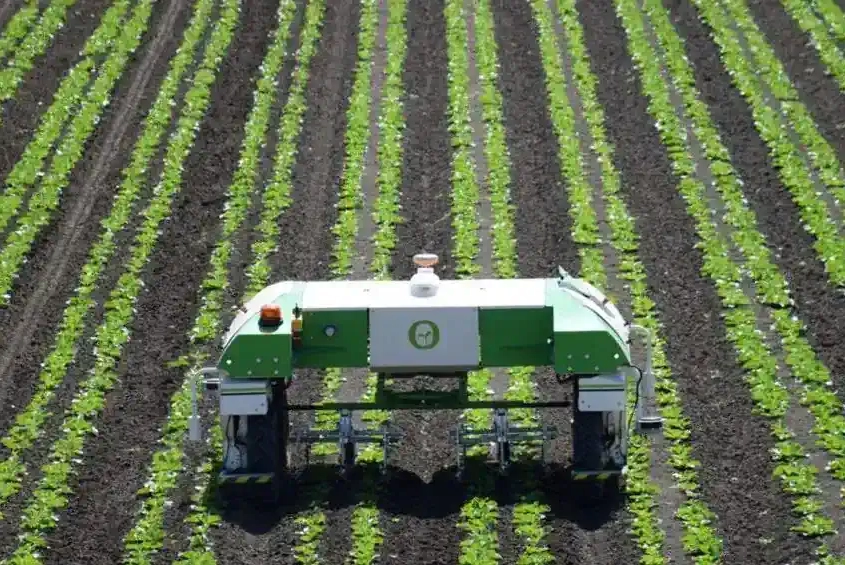 Fertilizer robots play a crucial role in modern agriculture by optimizing the fertilization process in row crops. Conventional fertilization methods often result in soil degradation and erosion due to the lack of consideration for specific plant needs. To address this challenge, precision agriculture applications utilize advanced technologies such as optical sensors and laser sensors. Multispectral cameras, for instance, analyze plant growth through NDVI indices, providing valuable insights for precise fertilization decisions. Laser sensors reconstruct vegetative environments, enabling analysis using clustering techniques and point cloud processing.The Sureveg project exemplifies the application of cutting-edge technologies in robotic fertilization processes for row crop production. By incorporating sensors, robotic systems, and control boards, this project aims to optimize selective fertilization through the extraction of crop characteristics and relevant decision-making information. Tests conducted on cabbage and red cabbage rows have demonstrated the effectiveness of these sensors, both individually and in combination, in enhancing the fertilization of vegetables.Fertilizer robots are part of the broader concept of smart agriculture, which encompasses various technologies and innovations revolutionizing farming practices. These technologies aim to increase efficiency, reduce labor requirements, and improve operational costs in the agricultural industry. Farm automation technologies, including fertilizer robots, have shown significant benefits such as cost savings per acre in vineyards. The adoption of these technologies is driven by factors such as rising fertilizer prices, concerns over inflation, increased labor wages, and stricter regulations on fertilizers and pesticides.Nanotechnologies also hold promise in agriculture, including the reduction of water usage in farming. These technologies leverage the unique properties of nanoparticles to enhance fertilizer efficiency and reduce environmental impact. Cynthia Goh, a Professor of Chemistry at the University of Toronto, highlights the potential of nanotechnologies in agriculture.In summary, fertilizer robots are integral to modern agriculture, optimizing the fertilization process in row crops and improving crop yield while reducing environmental impact. These robots, along with other smart agriculture technologies, aim to revolutionize farming practices by increasing efficiency, reducing labor requirements, and improving overall sustainability in the industry.
Fertilizer robots play a crucial role in modern agriculture by optimizing the fertilization process in row crops. Conventional fertilization methods often result in soil degradation and erosion due to the lack of consideration for specific plant needs. To address this challenge, precision agriculture applications utilize advanced technologies such as optical sensors and laser sensors. Multispectral cameras, for instance, analyze plant growth through NDVI indices, providing valuable insights for precise fertilization decisions. Laser sensors reconstruct vegetative environments, enabling analysis using clustering techniques and point cloud processing.The Sureveg project exemplifies the application of cutting-edge technologies in robotic fertilization processes for row crop production. By incorporating sensors, robotic systems, and control boards, this project aims to optimize selective fertilization through the extraction of crop characteristics and relevant decision-making information. Tests conducted on cabbage and red cabbage rows have demonstrated the effectiveness of these sensors, both individually and in combination, in enhancing the fertilization of vegetables.Fertilizer robots are part of the broader concept of smart agriculture, which encompasses various technologies and innovations revolutionizing farming practices. These technologies aim to increase efficiency, reduce labor requirements, and improve operational costs in the agricultural industry. Farm automation technologies, including fertilizer robots, have shown significant benefits such as cost savings per acre in vineyards. The adoption of these technologies is driven by factors such as rising fertilizer prices, concerns over inflation, increased labor wages, and stricter regulations on fertilizers and pesticides.Nanotechnologies also hold promise in agriculture, including the reduction of water usage in farming. These technologies leverage the unique properties of nanoparticles to enhance fertilizer efficiency and reduce environmental impact. Cynthia Goh, a Professor of Chemistry at the University of Toronto, highlights the potential of nanotechnologies in agriculture.In summary, fertilizer robots are integral to modern agriculture, optimizing the fertilization process in row crops and improving crop yield while reducing environmental impact. These robots, along with other smart agriculture technologies, aim to revolutionize farming practices by increasing efficiency, reducing labor requirements, and improving overall sustainability in the industry.3.4 Robot per la classificazione dei prodotti agricoli
Agricultural product grading robots offer immense potential for revolutionizing the agricultural industry. These robots integrate advanced technologies to automate the sorting and grading processes, ensuring consistent quality and efficiency. The introduction of these robots addresses the challenges posed by the complex and variable nature of agricultural products. Genetic and environmental factors contribute to the high variability observed in agricultural products, necessitating precise and adaptable grading systems. By employing image processing and perception technologies, agricultural product grading robots can accurately analyze the characteristics and quality of produce. This automation enhances productivity, reduces labor requirements, and ensures consistent product quality.Precision agriculture, which relies on the integration of robotics and advanced sensing technologies, has paved the way for the development and adoption of agricultural product grading robots. These robots play a vital role in the real-time interpretation of the agricultural environment, enabling efficient and accurate sorting and grading of products. By harnessing image processing techniques, these robots can analyze the visual characteristics of products, ensuring precise grading and sorting. The utilization of robotics in the agricultural sector has witnessed significant advancements over time, and agricultural product grading robots are at the forefront of this technological progress.In summary, agricultural product grading robots offer a promising solution for enhancing the sorting and grading processes in the agricultural industry. These robots leverage advanced technologies, such as image processing and perception systems, to automate the analysis of product characteristics and ensure consistent quality. By integrating robotics and sensing technologies, agricultural product grading robots contribute to increased productivity, reduced labor requirements, and improved overall efficiency in the agricultural sector.3.5 Robot diserbo
Weeding robots are a promising technology in modern agriculture, offering significant advantages in labor savings and reduced pesticide usage. Traditional weeding methods are labor-intensive and environmentally harmful, making the development of efficient and sustainable weed control solutions crucial. The integration of machine vision technologies in agricultural robots enables automated weeding robots that enhance efficiency, optimize resource utilization, and improve agricultural productivity. By leveraging computer vision, machine learning, and deep learning, weeding robots can accurately detect and remove weeds while preserving crops. These robots utilize perception, decision-making, and control technologies to navigate fields autonomously, providing effective weed management and reducing environmental pollution caused by herbicides.Leading agricultural technology companies have made significant strides in developing weeding robots that offer innovative solutions. For instance, CarbonRobotics has introduced an autonomous robot capable of distinguishing weeds from crops using laser technology. This robot employs artificial intelligence, high-resolution cameras, and powerful GPUs for image recognition, enabling precise weed elimination while preserving nearby crops. It operates with GPS and LIDAR systems, ensuring accurate navigation and obstacle avoidance. Similarly, Naïo Technologies has developed multiple weeding robots, such as Oz, Ted, and Dino, each designed for specific agricultural applications, employing camera vision, sensors, and precise tool positioning.Weeding robots present a significant opportunity for farmers to alleviate physical strain and protect crops efficiently. These robotic solutions offer a sustainable alternative to labor-intensive weeding practices, reducing reliance on agrochemicals and promoting environmental preservation. By harnessing advanced technologies and automation, weeding robots enhance agricultural practices, streamline operations, and contribute to the overall sustainability of the farming industry.3.6 Robot per piantine
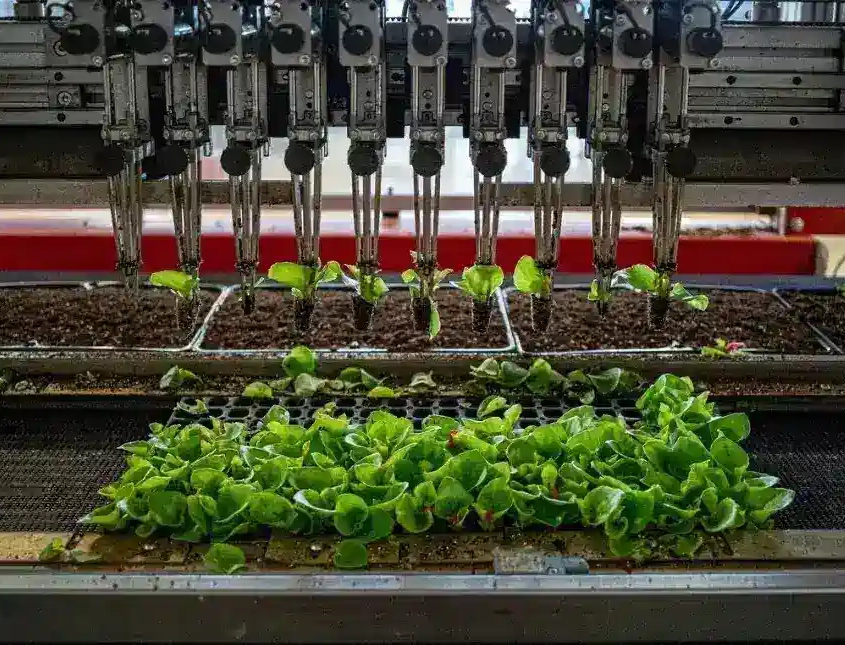 Agricultural robots are revolutionizing farming practices worldwide, including crop seeding. These robots offer a range of benefits, such as increased efficiency, reduced labor costs, and improved crop yields. The development of low-cost agricultural robots specifically designed for crop seeding has shown promising results. These robots utilize a mobile base and a seeding mechanism to sow seedlings into the ground continuously. In tests, the robot achieved a sowing rate of 138 seedlings in 5 minutes with 92% accuracy, outperforming human workers. The implementation of such robots in agriculture can significantly reduce labor costs and improve operational efficiency. By leveraging automation and eliminating the need for human intervention, crop production yields can be increased, and the industry can address labor shortages.The global market for agricultural robots, including seeding robots, is projected to reach USD 74.5 billion by 2024, indicating the increasing adoption and potential of these technologies. The integration of Artificial Intelligence (AI) in precision agriculture has enabled farmers to optimize inputs like fertilizer, pesticides, herbicides, and water, leading to increased yields. Additionally, aerial imaging drones equipped with sensors like RGB cameras provide valuable insights into crop health and soil conditions, empowering data-driven decision-making in agriculture. The use of various types of drones, including fixed-wing, rotary-wing, and hybrid drones, offers flexibility in agricultural applications.The development of smart agriculture robots, including those for crop seeding, addresses the challenges faced by farmers in terms of labor scarcity and changing environmental conditions. By employing sensors and automation, these robots save time, enhance energy efficiency, and optimize crop productivity. The utilization of advanced technologies, such as Arduino boards and wireless communication, allows precise control and monitoring of the robotic vehicles. The development of such innovative robotic systems contributes to the advancement of agricultural robotics and opens up possibilities for broader applications in the industry.The progress in agricultural robotics, including crop seeding robots, is driven by the need for increased efficiency, reduced labor costs, and optimized crop yields. These robots leverage computational algorithms, environmental perception, and precision technologies to enhance production processes. Precision agriculture, enabled by small smart devices like sensors, drones, and trackers, allows for optimized detection, spraying, weeding, and harvesting of crops. The advancements in agricultural robotics, including crop seeding robots, contribute to the commercialization and ongoing development of these technologies in the agricultural sector.
Agricultural robots are revolutionizing farming practices worldwide, including crop seeding. These robots offer a range of benefits, such as increased efficiency, reduced labor costs, and improved crop yields. The development of low-cost agricultural robots specifically designed for crop seeding has shown promising results. These robots utilize a mobile base and a seeding mechanism to sow seedlings into the ground continuously. In tests, the robot achieved a sowing rate of 138 seedlings in 5 minutes with 92% accuracy, outperforming human workers. The implementation of such robots in agriculture can significantly reduce labor costs and improve operational efficiency. By leveraging automation and eliminating the need for human intervention, crop production yields can be increased, and the industry can address labor shortages.The global market for agricultural robots, including seeding robots, is projected to reach USD 74.5 billion by 2024, indicating the increasing adoption and potential of these technologies. The integration of Artificial Intelligence (AI) in precision agriculture has enabled farmers to optimize inputs like fertilizer, pesticides, herbicides, and water, leading to increased yields. Additionally, aerial imaging drones equipped with sensors like RGB cameras provide valuable insights into crop health and soil conditions, empowering data-driven decision-making in agriculture. The use of various types of drones, including fixed-wing, rotary-wing, and hybrid drones, offers flexibility in agricultural applications.The development of smart agriculture robots, including those for crop seeding, addresses the challenges faced by farmers in terms of labor scarcity and changing environmental conditions. By employing sensors and automation, these robots save time, enhance energy efficiency, and optimize crop productivity. The utilization of advanced technologies, such as Arduino boards and wireless communication, allows precise control and monitoring of the robotic vehicles. The development of such innovative robotic systems contributes to the advancement of agricultural robotics and opens up possibilities for broader applications in the industry.The progress in agricultural robotics, including crop seeding robots, is driven by the need for increased efficiency, reduced labor costs, and optimized crop yields. These robots leverage computational algorithms, environmental perception, and precision technologies to enhance production processes. Precision agriculture, enabled by small smart devices like sensors, drones, and trackers, allows for optimized detection, spraying, weeding, and harvesting of crops. The advancements in agricultural robotics, including crop seeding robots, contribute to the commercialization and ongoing development of these technologies in the agricultural sector.3.7 Robot agricolo
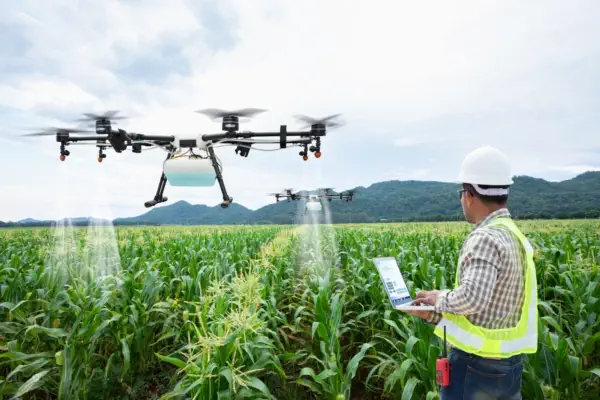 he adoption of farming robots in agriculture brings about significant transformations compared to traditional working methods. These robots offer several advantages and challenges that impact various dimensions of farm operations. The integration of perception, decision-making, control, and execution techniques has led to notable improvements, but limited integration with artificial intelligence remains a restriction for widespread use. However, farming robots are emerging as crucial contributors to digital agriculture, offering benefits such as flexibility, precision, increased productivity, and continuous operation without breaks . These robots can perform tasks like planting, irrigation, fertilization, monitoring, and harvesting, reducing the need for human labor. They operate at higher speeds, with fewer errors, and navigate obstacles effectively, leading to improved product quality and lower production costs.The introduction of farming robots in agriculture also brings about transformations in farm structure, work organization, the meaning of work, and technical-economic performance. While the impact on work is complex, studies indicate that farm size is not necessarily correlated with robotization. Skill and wage segmentation may occur in the labor market, and work reorganization involves a decrease in physical workload but an increase in mental workload for monitoring alarms. Changes in the animal-human relationship can also lead to new farmer and worker identities. However, it's important to note that the adoption of automated milking systems did not support a reduction in working time.Smart farming and digital agriculture, enabled by agricultural robots, address challenges such as labor shortages, declining agricultural populations, and cultivation uncertainty due to climate change. These robots, including aerial and ground robots, facilitate data collection and crop management through remote sensing. They are increasingly utilized for tasks such as monitoring, spraying, and harvesting, reducing labor shortages and long-term costs. However, agricultural environments pose challenges due to crop diversity and varying robot platforms. Despite challenges such as high initial costs, maintenance requirements, and potential job displacement, robotics in agriculture offer effective solutions for improving productivity and transforming the industry.The advancements in agricultural robotics have resulted in the emergence of various types of farming robots capable of performing tasks like picking apples, harvesting lettuce, gathering strawberries, and removing weeds. These robots are driven by the need to address labor shortages and meet the growing global population's demands for food. While automation seems suitable for crop harvesting, the delicate nature of fruits and vegetables presents challenges for precise robot operations. Nonetheless, advancements made by agtech companies and academic institutions have shown promise in developing robots capable of picking ripe fruit and handling lettuce harvesting. These innovations have the potential to transform the industry and contribute to meeting critical agricultural needs.
he adoption of farming robots in agriculture brings about significant transformations compared to traditional working methods. These robots offer several advantages and challenges that impact various dimensions of farm operations. The integration of perception, decision-making, control, and execution techniques has led to notable improvements, but limited integration with artificial intelligence remains a restriction for widespread use. However, farming robots are emerging as crucial contributors to digital agriculture, offering benefits such as flexibility, precision, increased productivity, and continuous operation without breaks . These robots can perform tasks like planting, irrigation, fertilization, monitoring, and harvesting, reducing the need for human labor. They operate at higher speeds, with fewer errors, and navigate obstacles effectively, leading to improved product quality and lower production costs.The introduction of farming robots in agriculture also brings about transformations in farm structure, work organization, the meaning of work, and technical-economic performance. While the impact on work is complex, studies indicate that farm size is not necessarily correlated with robotization. Skill and wage segmentation may occur in the labor market, and work reorganization involves a decrease in physical workload but an increase in mental workload for monitoring alarms. Changes in the animal-human relationship can also lead to new farmer and worker identities. However, it's important to note that the adoption of automated milking systems did not support a reduction in working time.Smart farming and digital agriculture, enabled by agricultural robots, address challenges such as labor shortages, declining agricultural populations, and cultivation uncertainty due to climate change. These robots, including aerial and ground robots, facilitate data collection and crop management through remote sensing. They are increasingly utilized for tasks such as monitoring, spraying, and harvesting, reducing labor shortages and long-term costs. However, agricultural environments pose challenges due to crop diversity and varying robot platforms. Despite challenges such as high initial costs, maintenance requirements, and potential job displacement, robotics in agriculture offer effective solutions for improving productivity and transforming the industry.The advancements in agricultural robotics have resulted in the emergence of various types of farming robots capable of performing tasks like picking apples, harvesting lettuce, gathering strawberries, and removing weeds. These robots are driven by the need to address labor shortages and meet the growing global population's demands for food. While automation seems suitable for crop harvesting, the delicate nature of fruits and vegetables presents challenges for precise robot operations. Nonetheless, advancements made by agtech companies and academic institutions have shown promise in developing robots capable of picking ripe fruit and handling lettuce harvesting. These innovations have the potential to transform the industry and contribute to meeting critical agricultural needs.4. Batterie al litio per robot agricoli
Batterie agli ioni di litio play a crucial role in powering agricultural robots, offering numerous advantages over other battery technologies. These batteries provide high energy density, reliability, and faster charging capabilities, making them ideal for the demanding requirements of agricultural applications. Manly Battery offers specialized lithium-ion battery solutions tailored for small and medium-sized agricultural robots, including driverless transport vehicles and forklifts. These modular and expandable batteries, such as the "Easy Block" and "Easy Blade," come in various versions with different power outputs, voltages, and energy capacities. For example, the "Easy Block" pack offers voltages ranging from 12.8 to 38.4 volts, while the "Easy Blade" pack provides voltage options between 24 and 48 volts.Lithium-ion batteries have proven to be reliable and eco-friendly solutions for the energy requirements of agricultural robots. They offer longer lifespans, higher energy densities, and improved power and load capacities compared to lead-acid batteries, all in a smaller form factor. With their advanced technology, lithium-ion batteries contribute to operational efficiency in agricultural applications by reducing head length in truck and pallet loading, enabling narrower aisles, and maximizing storage space. Manly Battery, as a sustainable partner in the agricultural robotics sector, provides both standard and customizable lithium-ion battery options to meet the diverse needs of users and support the industry's growth.In the agricultural robotics market, battery power is crucial, considering factors such as accessibility, reliability, longevity, convenience, and cost. While lead-acid batteries were commonly used in the past, many designers are transitioning to fosfato di litio-ferro (LFP), lithium nickel cobalt aluminum (NCA), or lithium nickel manganese cobalt (NMC) technologies for improved energy density and cycle life. Manly Battery's experience in battery technology, such as the transition from lead-acid to NMC technology, demonstrates the significant benefits and market acceptance of lithium-ion batteries in terms of higher energy density, efficiency enhancements, and extended warranties. The use of cylindrical 18650 or 21700 cells allows for greater granularity in the design of the battery system.Lithium-ion batteries also find extensive use in the automated guided vehicles and autonomous mobile robots (AGV/AMR) market, providing advantages such as longer run times, lighter loads, and faster, more efficient charging compared to lead-acid batteries. These batteries prove to be the optimal choice for mobile robots in various industries, including agriculture, as they offer superior performance, increased productivity, and enhanced workplace safety. While the exact voltages of lithium-ion batteries for agricultural robots may vary depending on specific applications and configurations, they typically range from 12.8 to 48 volts .In summary, lithium-ion batteries provide the necessary power, reliability, and energy density required for agricultural robots. With their advanced technology and customizable options, these batteries contribute to the sustainable and efficient operation of autonomous mobile robots in agriculture.